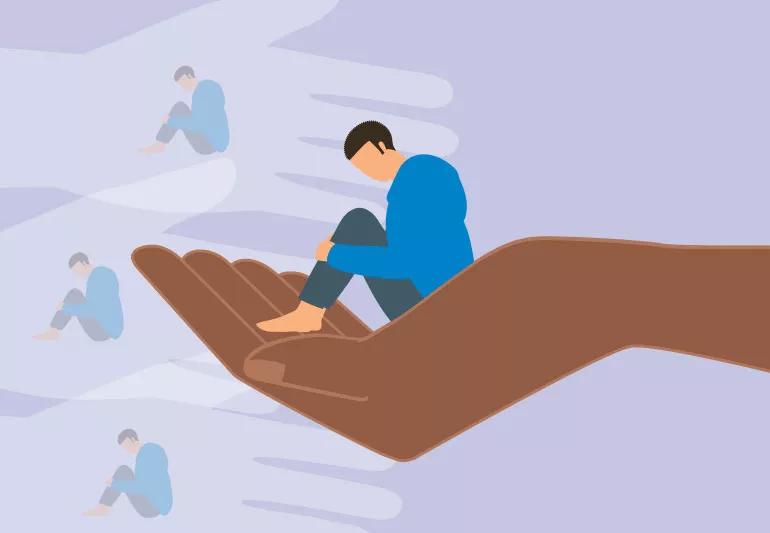When ‘helping’ others is unhealthy for you, it’s time to set firm boundaries

When someone you love is struggling, it’s natural to want to help. Selflessness is a virtue, after all, isn’t it?
Advertisement
Cleveland Clinic is a non-profit academic medical center. Advertising on our site helps support our mission. We do not endorse non-Cleveland Clinic products or services. Policy
But when “helping” crosses the line to enabling your loved one’s problematic behavior to continue, it can be a real detriment to your well-being — physically, mentally, socially and even financially. And it’s counterproductive to the person you’re trying to help.
“When you’re consistently rescuing a loved one from the potential consequences of their choices or behaviors, the likelihood is you’re not actually doing them any favors in the long run,” explains clinical psychologist Adam Borland, PsyD.
We asked Dr. Borland about the signs of enabling, and how to put an end to the cycle of nonproductive “helping.”
Enabling happens when you justify or support problematic behaviors in a loved one under the guise that you’re helping them. That can be things like giving money to an adult child who hasn’t spent theirs wisely. Or making excuses for a spouse’s anger management issues.
Enabling is often associated with conditions like alcohol use disorder or substance use disorder. We often hear about enabling in the context of a loved one who steps in to support a person living with addiction in an attempt to keep them from “hitting rock bottom” or experiencing the consequences of their actions. But enabling happens in many other contexts as well.
Advertisement
“Enabling usually comes from a place of love,” Dr. Borland explains. “We don’t want to see our friends or family struggling. We want to make them feel better. So, we do whatever we think will help them.”
Enabling creeps up when your “help” keeps others from improving themselves — and it can take a toll on your own well-being.
There’s nothing wrong with helping others from time to time. No one is saying you should never give a friend a ride to the store when their car breaks down. Or that it’s necessarily problematic to help an adult child pay an overdue bill here or there. That kind of thing happens sometimes, and it’s probably OK.
The difference is that enabling takes helping to an extreme.
“Enabling happens when you see a loved one making unhealthy life choices, so you assume the role of problem solver. But your help keeps them from learning to make better choices and to stand on their own two feet,” Dr. Borland says. “Enabling can become a vicious cycle.”
Enabling can come in a lot of shapes and sizes. It happens between partners in romantic relationships. In the dynamics between parents and their grown children. Between friends and colleagues.
The specifics can change, but at its core, enabling behavior tends to have some common themes. Dr. Borland walks us through some examples:
Often, we think we’re helping others because we want to. But in an enabling relationship, a person who’s used to being enabled will come to expect your help. So, you step in and fulfill those needs in order to avoid an argument or other consequence.
Enabling becomes less like making a choice to be helpful and more like helping in an attempt to keep the peace. It may be a decision you make consciously or not, but at the root of your behavior is an effort to avoid conflict.
When helping becomes a way of avoiding a seemingly inevitable discomfort, it’s a sign that you’ve crossed over into enabling behavior.
Enabling can also be a way of protecting those we love from others’ scrutiny — or protecting ourselves from acknowledging a loved one’s shortcomings.
Making excuses can be one way you help cover up problematic behavior and keep your loved one from being held accountable for their actions. For example:
Advertisement
You already have responsibilities in your life. You may need to take care of children or aging parents. You have bills to pay. Appointments to get to. A job that depends on you.
So, when you start taking on tasks to help others, it’s only natural that eventually something has to give. Trying to manage your own life along with others’ starts to wear down your reserves.
“Think of your capacity to give like a gas tank,” Dr. Borland illustrates. “If you’re giving and giving and giving to someone else, eventually, you’re going to start running on empty. There are consequences to our own well-being when we enable others.”
The more you spend time, energy and financial resources on others, the more effect it can have on your own well-being.
Enabling can be hard to spot for the people within the enabling relationship. It’s often easier to see from the outside looking in.
“When you’re on the inside of an enabling dynamic, most people will think they’re just doing what’s best, that they’re being selfless or virtuous. In a lot of cases, it’s other people around you who are more likely to recognize that you’re helping someone who isn’t helping themselves,” Dr. Borland explains.
Advertisement
If a loved one brings to your attention that your behavior may not be beneficial to you or the person you’re enabling, take some time to consider it. They may be seeing things more clearly than you can.
If this is sounding familiar, it may be time to reassess your role in allowing problematic behaviors to continue.
But how?
First is recognizing that you’re contributing to a cycle of enabling. That is, accept that you’ve played a part in perpetuating unacceptable behaviors in your loved one and make a commitment to breaking the cycle.
From there, it’s time for a talk.
“You have to establish and maintain firm boundaries,” Dr. Borland advises. “The person needs to know that they can no longer manipulate the situation as they’ve done in the past.”
It’s not that you need to cut the person out of your life necessarily, but they need to know that they are no longer welcome to come to you for support. No more money. No more rides. No more excuses. None of it. Period. Hard stop.
That’s easier said than done a lot of times.
“Ending an enabling relationship requires assertiveness — the ability to say no,” Dr. Borland says. “For a lot of people, learning to be assertive is a new and potentially uncomfortable skill set.
Advertisement
Support groups like Al-Anon may be useful for people whose loved ones are living with addiction. And talk therapy, Dr. Borland suggests, can be helpful for anyone who finds themselves in an enabling situation or who could benefit from developing assertiveness.
“Enabling doesn’t mean you’re the ‘bad guy.’ You’re put in a very difficult position because you love this person and you’re trying to make the best of a bad situation,” Dr. Borland reassures. “But it’s important to recognize when enough is enough and to make changes, for their good and your own.”
Learn more about our editorial process.
Advertisement

Always putting others’ happiness before your own can build resentment over time

Learn how to tame your brain’s inner rebel

Catching and responding to passive-aggressive behavior can be difficult

Paying attention and opening the lines of communication are key to supporting your child

While playing can increase brain matter and improve cognitive function, balance is key

988 updates and replaces the old suicide hotline

Type 2 diabetes isn’t inevitable with these dietary changes

Applying a hot or cold compress can help with pain